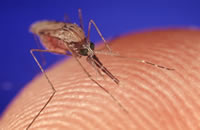|
|
|||||
|
|
On
This Page: Factors That Determine The Occurrence of MalariaFactors that determine the occurrence of malaria are those that influence the three components of the malaria life cycle:
Notes:
ClimateClimate can influence all three components of the life cycle. It is thus a key determinant in the geographic distribution and the seasonality of malaria. Rainfall can create collections of water ("breeding sites") where Anopheles eggs are deposited, and larvae and pupae develop into adulthood, a process that takes approximately 9-12 days in tropical areas. Such breeding sites may dry up prematurely in the absence of further rainfall, or conversely they can be flushed and destroyed by excessive rains. Once adult mosquitoes have emerged, the ambient temperature, humidity, and rains will determine their chances of survival. To transmit malaria successfully, female Anopheles must survive long enough after they have become infected (through a blood meal on an infected human) to allow the parasites they now harbor to complete their growth cycle ("extrinsic" cycle). That cycle takes 9-21 days at 25°C or 77°F. Warmer ambient temperatures shorten the duration of the extrinsic cycle, thus increasing the chances of transmission. Conversely, below a minimum ambient temperature (15°C or 59°F for Plasmodium vivax, 20°C or 68°F for P. falciparum), the extrinsic cycle cannot be completed and malaria cannot be transmitted. This explains in part why malaria transmission is greater in warmer areas of the globe (tropical and semitropical areas and lower altitudes), particularly for P. falciparum. It has been speculated that current trends of global warming may increase the geographic range of malaria and may be responsible for malaria epidemics. Climate also determines human behaviors that may increase contact with Anopheles mosquitoes between dusk and dawn, when the Anopheles are most active. Hot weather may encourage people to sleep outdoors or discourage them from using bed nets. During harvest seasons, agricultural workers might sleep in the fields or nearby locales, without protection against mosquito bites. Anopheles MosquitoesWhat types (species) of Anopheles are present in an area at a given time will influence the intensity of malaria transmission. Not all Anopheles are equally good "vectors" for transmitting malaria from one person to another. Some species are biologically unable to carry human malaria parasites, while others are readily infected and produce large numbers of sporozoites (the parasite stage that is infective to humans).
Different Anopheles species may differ in selected behavior traits, with important consequences on their abilities as malaria vectors. In some species the females prefer to get their blood meals from humans ("anthropophilic") while in others they prefer animals ("zoophilic"). Some species prefer to bite indoors ("endophagic"), and others prefer outdoor biting ("exophagic"). All other factors being equal, the anthropophilic, endophagic species will have more frequent contacts with humans and thus will be more effective malaria vectors. Some species prefer to rest inside the dwellings where they have just obtained their blood meals ("endophilic") while others prefer to rest outdoors ("exophilic"). The endophilic species will be more likely to acquire lethal doses of insecticides sprayed on the walls of the dwellings (a malaria control measure called "indoor residual spraying") while this will not be the case for the exophilic species. An important biologic factor is insecticide resistance. If the mosquitoes are resistant to the insecticide(s) used locally for spraying or for treating bed nets, these measures will be ineffective in curtailing transmission.
HumansBiologic characteristics (inborn and acquired) and behavioral traits can influence an individual's malaria risk and, on a larger scale, the intensity of transmission in a population.
Parasites
Characteristics of the malaria parasite can influence the occurrence of malaria and its impact on human populations:
Areas Where Malaria Is No Longer EndemicMalaria transmission has been eliminated in many countries of the world, including the United States and countries of western Europe. However, cases of malaria still occur in these countries, mostly in returning travelers or immigrants ("imported malaria"). All patients must be diagnosed and treated promptly for their own benefit but also to prevent the reintroduction of malaria.
Page last modified : April 30, 2004 Content source: Division of Parasitic Diseases National Center for Zoonotic, Vector-Borne, and Enteric Diseases (ZVED)
|
|
||||||||||||||||||||||||
| Home | Policies and Regulations | Disclaimer | e-Government | FOIA | Contact Us | ||||||
|




